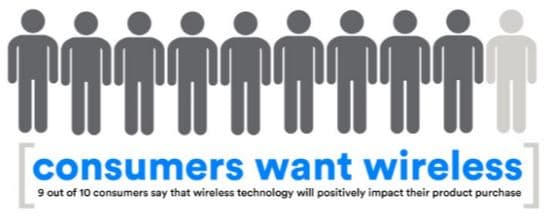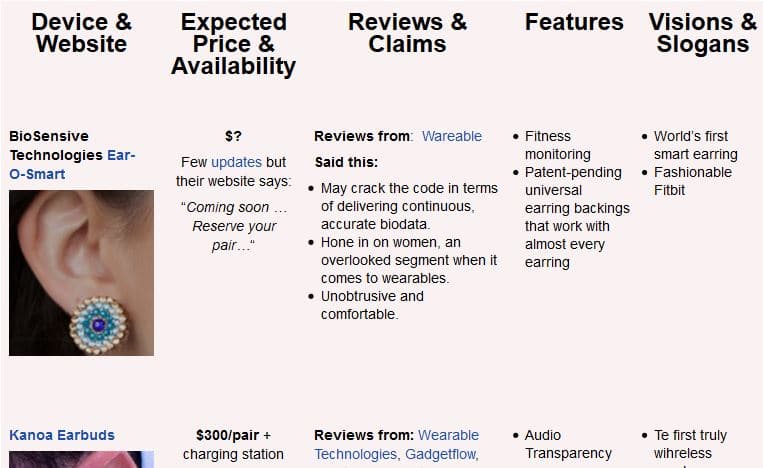Last post reviewed and started categorizing Hearables of yesteryear and now, parsing out ear level devices no longer on the table and others that aren’t wireless, Smart, or binaural. Survivors that remain in the development stage are the next level of this Hearables taxonomy. They comprise today’s post, with the repeated caveat that the list is representative, not comprehensive.
Form Follows Function
 Hearables in the oven are being baked to consumers’ tastes for preferred functions, all ideally packaged in wireless form.
Hearables in the oven are being baked to consumers’ tastes for preferred functions, all ideally packaged in wireless form.
Fitness: …there is growth momentum for emerging consumer tech segments such as portable wireless speakers, fitness trackers, and wireless/Bluetooth headphones. (Healthcare IT News)
Voice Assistants: The percentage of U.S. smartphone owners using voice search has reached 65% in 2015 — up from 56% in 2014 — and 30% in 2013, according to our most recent data. (Thrive Analytics)
Music Streaming: Streaming revenue has exploded, growing 57.4 percent overall … (compared to) the first half of 2015. (Billboard)
Personalization: Sound shaping, augmented audio reality, noise reduction, targeted listening, real time feedback and coaching — all are envisioned in Hearables designs shown below.
Technological advancements are growing the Hearables market as the ear canal becomes the preferred form to meet these functions. Music and voice in the ears seem obvious, since they require hearing, and binaural input whenever possible. But consumers don’t want to listen to music or voice in either ear unless quality and accuracy are satisfactory. No problem thanks to tech advances. Voice recognition accuracy has improved to 90%, up from 70% in 2011 (Peaslee, 2016); quality of users’ speech in noise is optimized in Hearables equipped with Knowles’ Versant advanced voice technology.
A quick scan of column 5 in the table below convinces that many Hearable designs are pursuing music (and other sound) technological perfection by “flawlessly” synchronizing wireless streaming and minimizing Bluetooth interaural attenuation and transmission latency effects. Column 4 convinces that many Hearables designs are out to capture biometrics of all sorts, with the idea that the ear canal location enables more accuracy than can be had on the wrist, not to mention that ears are hands free and they come in pairs.
It’s A Vision Thing
Observing consumer preferences, technological advances, and convergences in the ear canal, Wayne Staab observed that “hearables are moving more toward hearing aids than the other way around.” Going the other way around, hearing aid manufacturing embracing Hearable functionality to grow its markets, as evidenced by GN Nord’s 2015 Annual report commentary:
In 2015, GN Netcom took an important step in the re-positioning of the product offering in the Mobile segment toward products where music and voice converge. During the IFA trade show, GN Netcom launched Jabra Halo Fusion – a neckworn headset designed to meet the demands of daily audio and media consumption as well as voice communication. (ital added)
The vision is to leverage technology to change our basic understanding of what our ears are for and what they can do for us, per the strutting slogans coined by Hearable companies to differentiate their products (last column of table). They’re to-the point (Truly wireless), clever (The last thing you’ll ever put in your ears.), entertaining and thought-provoking (Not Just Another Wireless Earbud, We’re So Much Smarter Than That.)
Every vision needs a messianic spokesman to weave the magic and get others on board. Doppler Labs CEO seems like a good fit for the role, judging from his gifted gab and the media attention to Doppler’s Hearable (see column 3 of table):
- Wireless is “table-stakes stuff” not nearly as interesting as changing the way we hear altogether. (Kraft)
- “We are not a medical device but we do think there is this crazy false binary, that people either can hear of can’t hear.” (Kraft)
- If Microsoft put a computer on every desk, and Apple put a computer in every pocket, at Doppler Labs, we want to put a computer, speaker, and microphone in everyone’s ears.” (Kraft)
Next post in this series will reach the pinnacle of the Hearable taxonomy — devices that are actually available to purchase and fit into your two ears. And, we’ll hear more from Mr. Kraft as he tunes up the market in preparation for debut of his own company’s product.
References and Footnotes
Christman E. Streaming Helps Drive 8.1 Percent Growth in Revenue for U.S. Recording Industry. Billboard, 9/20/2016.
Peaslee J. Adoption of voice search continues to gain traction. Thrive Analytics. June 6, 2016.
Sarasohn-Kahn J. Wearable activity tracking device purchasing expected to grow 11 percent in 2016. Healthcare IT News. May 5, 2016.
Taplett N. At home, in the car, and anywhere you can imagine. Bluetooth Blog. April 29, 2016.
1Waverly Labs Pilot isn’t a binaural unit, but it’s interesting and does have two ears involved, just not on the same head.
This is the 16th post in the Hearables series. Click here for post 1, post 2, post 3, post 4, post 5, post 6, post 7, post 8, post 9, post 10,post 11, post 12, post 13 , post 14, post 15.
feature image from pixar planet






